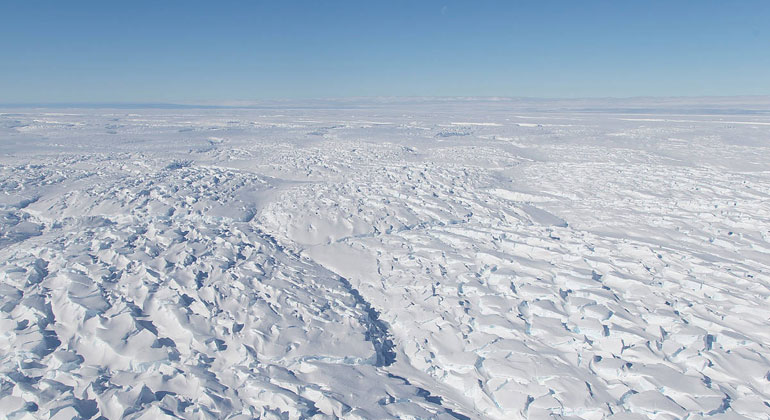The future of the Thwaites Glacier in West Antarctica
UK and US join forces to understand how quickly a massive Antarctic glacier could collapse
A joint UK-US research programme launched today is one of the most detailed and extensive examinations of a massive Antarctic glacier ever undertaken. The Alfred Wegener Institute directly participated in an expedition during which researchers explored the structure of the ice and of the ground below it.
The collapse of the Thwaites Glacier in West Antarctica could significantly affect global sea levels. It already drains an area roughly the size of Britain or the US state of Florida, accounting for around four per cent of global sea-level rise —an amount that has doubled since the mid-1990s.
As part of a new £20 million research collaboration, the UK Natural Environment Research Council and the US National Science Foundation will deploy scientists to gather the data needed to understand whether the glacier’s collapse could begin in the next few decades or centuries.
NERC and NSF have jointly funded eight large-scale projects that will bring together leading polar scientists in one of the most inhospitable regions of the planet. The programme, called the International Thwaites Glacier Collaboration (ITGC), is the largest joint project undertaken by the two nations in Antarctica for more than 70 years – since the conclusion of a mapping project on the Antarctic Peninsula in the late 1940s.
Today’s collaboration involves around 100 scientists from world-leading research institutes in both countries alongside researchers from South Korea, Germany, Sweden, New Zealand and Finland, who will contribute to the various projects.
The Alfred Wegener Institute directly participates in an expedition during which researchers explore the structure of the ice and of the ground below it. The vibroseis method makes it possible to gain better data, both quantitatively and qualitatively, than with conventional explosives-based methods. The Alfred Wegener Institute is the only organisation worldwide that has established the use of this method for ice and possesses the corresponding equipment.
“As such, we were very pleased to be able to share our expertise in the project,” says Olaf Eisen from the Alfred Wegener Institute. “In concrete terms, our goal is to find out the nature of the ground below the glacier: whether it’s solid rock or soft sediments and, if it’s the latter, if they are wet or dry. All of these aspects have a major influence on how the glacier moves along the ground, and on how that might change in the future.”
Antarctica’s glaciers contribute to sea-level rise when more ice is lost to the ocean than is replaced by snow. To fully understand the causes of changes in ice flow requires research on the ice itself, the nearby ocean, and the Antarctic climate in the region. The programme will deploy the most up-to-date instruments and techniques available, from drills that can make access holes 1,500 meters into the ice with jets of hot water to autonomous submarines like the Autobsub Long Range affectionately known around the world as Boaty McBoatface.
In addition to the £20 million-worth of awards to the research teams, the logistics of mounting a scientific campaign in one of the most remote places in Antarctica could cost as much again in logistical support. The nearest permanently occupied research station to the Thwaites Glacier is more than 1600km away, so getting the scientists to where they need to be will take a massive joint effort from both nations. While researchers on the ice will rely on aircraft support from UK and U.S. research stations, oceanographers and geophysicists will approach the glacier from the sea in UK and U.S. research icebreakers.
The science programme and logistics on the five-year programme begins in October 2018 and continues to 2021. The funding is for eight research projects and a co-ordination grant to maximise success. The science activities and information gathered will be disseminated through several outreach and media-aimed efforts in the UK and US, and with websites and blogs. The data gathered by ITGC will be archived and freely shared at the end of the program to help future understanding of the area.








